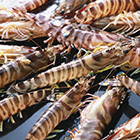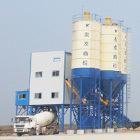Exploring the cultivation and breeding techniques of the worm
Release Time:
2016-04-11 00:00
Egg hatching → inoculation → aquaculture management → Artemia spawning → egg harvesting
Construction of the culture pond and preparation before seeding: Construction of the culture pond The depth of the culture pond is 1m, the size is 50X50m, and the four sides of the pool have annular grooves with a water depth of 70-100cm. At the same time, the algae bait culture pond was built, and the phytoplankton grew faster in the low salinity environment. Disinfection Before cultivating the Artemia, completely empty the pool, expose it for 2 weeks, clean the pond sediment as needed, and then scatter the lime at the bottom of the pond.
Incubation of eggs: Incubation apparatus consists of an incubator and a small air pump. The incubator is in the shape of a circular barrel made of plexiglass or plastic, and the bottom is funnel-shaped. Disinfect the incubator with a brush and clean water, clean the incubator and the inflation tube, and sterilize the tank wall with a strong hypochlorous acid solution. After 1-2 hours, rinse off the disinfectant with water until the smell of chlorine is not smelled.
Sterilization of eggs: The eggs to be hatched are placed in a hypochlorous acid solution containing 200 mg/kg for 20 minutes and continuously inflated; the sterilized eggs are collected with a filter and thoroughly rinsed before being placed in the incubator.
Preparation before hatching: fill the incubator with filtered brine; install the aeration system; disinfection water is added 0.5g of effective chlorine per 100L of tank water and inflated for about 1 hour; 0.5g of thiosulfuric acid is added to the water Sodium, remove the remaining chlorine.
Incubation conditions: The conditions for hatching of Artemia eggs are important factors affecting the hatching rate of eggs. The main criteria for control of incubation conditions are as follows. Water: 25 ‰ 35 ‰ brine; temperature: 25-30 ° C; aeration: fully agitate the water, avoid excessive foam, oxygen is not less than 2mg / L; pH: greater than 8; light: water surface is 2000lx; Density: The density of hatching Artemia eggs is 3 g/L. During the hatching process of the eggs, it is necessary to observe whether the hatching rate of the eggs is high, whether the hatching synchronization is good, and whether the larval vitality is strong. The shorter the incubation time, the smaller the hatching body is, the better the vigor is, the better the egg quality is. If the hatching time exceeds 24 hours, the egg is the next year. The longer the hatching time, the better the egg quality. The worse. Quality inspection essentials Touch: For wet eggs, the hand can be spread, no ice crystals, the moisture is about 40%; dry eggs with high dryness and good dispersion are good. Smell: Smell, smell-free quality is good.
Visual inspection: The particles should be uniform in size, consistent in color, and free from impurities. Microscopic examination: further observation of the size, impurities, empty shells, but also to see if there are depressions (with depressions). Randomly sampled, take a small amount of eggs and evenly placed on the glass slides, observe with an optical microscope, good eggs like the ping-pong table tennis, and the round eggs are wet eggs or empty eggs. Observe the attachments outside the egg shell with or without crystalline substances, good quality eggs, crystals or other impurities outside the egg shells, or little or no impurities; if there are many crystals and impurities, it means that the eggs have not been washed or precipitated after being picked up. deal with. Observe the breakage rate of the egg: the breakage rate of the egg is inversely proportional to the egg mass, and the higher the breakage rate, the lower the egg quality. The breakage rate of fresh eggs is very low, and the breakage rate of the eggs is higher.
Observe the diameter of the egg: if the egg diameter is small and the size is the same, the egg quality is good; if the egg diameter is different, it is an untreated fresh egg. Combustion measurement: Every good Artemia egg burns on the fire will produce small water droplets. Therefore, in the identification, you can put some eggs on the glass slide and burn with fire to see if the number of small water droplets produced is similar to the number of eggs.
Inoculation: salinity: 100‰150‰; temperature: 15°C; pH: 7.9-8.9; density: 100 nauplii/L; bait culture pond brine transparency less than 30cm; water depth: 30-70cm . Inoculation precautions The inoculation time should be arranged in the evening as much as possible. At this time, the water temperature is the highest, which is conducive to the rejuvenation of the nauplii; in high wind conditions, the nauplii must be siphoned into the pool at the leeward pool to prevent the nauplii from being washed. To the shore; if the hatchery is far from the pond, it needs to be cooled and oxygenated during transport. Factors such as hatching rate of eggs and survival rate of nauplii should be considered when calculating the inoculation density. Aquaculture management: Routine testing of environmental conditions Temperature, water and bottom temperature, pH, water depth, water transparency, dissolved oxygen. Monitoring of Artemia Growth The sampling of Artemia requires a fixed point at the distribution pool. When sampling, the brine shrimp at the bottom of the pool should be stirred up to ensure the accuracy of sampling. The filters were filtered, classified and counted with 500μm, 375μm and 125μm pore size filters respectively to analyze the population structure and observe the disease and death. Nutritional monitoring of water bodies Maintaining a good phytoplankton population is key to the success of Artemia farming. Therefore, routine monitoring of the nutrient levels of water bodies and the condition of plankton is very important and can provide a basis for daily management. The cultivation of bait and the feeding materials are mainly based on the fertilizer water and the rich brine supplemented by the biological bait in the initial stage of breeding, so that the transparency is kept at about 30cm. With the growth and development of Artemia, it is necessary to gradually feed organic debris such as bran and oil cake. Class, corn, chicken manure, cattle and sheep manure, etc. The granules should be less than 50μ, and the feeding amount should be 30-50kg/day·ha, which should be fed in several stages. Inorganic fertilizer can be used under conditions, and 20 kg of urea and 25 kg of diammonium phosphate are applied per hectare of water per week.
Prevention and control of pests and diseases When breeding, attention should be paid to the prevention of black body diseases, while preventing water birds from feeding on Artemia in shallow waters. Pick up the chaetoceros and canola in a timely manner, and feed the brine shrimp with a colloid mill. Futian set up a sunscreen net to provide a summer shelter for Artemia. Stimulation of spawning: Factors affecting the spawning of Artemia are the genetic characteristics of Artemia, environmental factors (dissolved oxygen, salinity, temperature, etc. to stimulate the synthesis of Artemia hemoglobin, and finally hemene as the final product of metabolism, Secreted by the brown shell gland to form the Artemia egg shell). Method of regulating spawning Change the salinity of the brine in the culture pond, such as increasing or decreasing salinity; reducing the amount of dissolved oxygen; and stimulating by chemical drugs. Fishing processing: Egg fishing: Artemia eggs are harvested in the fall. Can be scraped directly from the shore, or use a special small dip net to pick up eggs floating in the water or suspended water in the downwind. If used to collect Artemia eggs that are blown to the shore by the wind, a square dip net (40 mesh above mesh and 90 mesh below) is commonly used; if used to collect Artemia eggs in water, a circular dip net is often used. In addition, it is also possible to dig a pit or construct a floating gate to concentrate the eggs in the local water body for harvesting. Freshly collected eggs should not be piled up. Easy processing Cleaning: Use a conical bucket, rinse with fresh water, then rinse with brine. The main purpose of rinsing is to remove debris, egg shells and dirt on the surface. Dehydration: The method of dehydrating wet eggs is to first centrifuge and then dry. Drying: During the drying process, it is necessary to prevent the temperature from being too high (not exceeding 40 ° C) and exposure to sunlight (dry eggs are generally stored at low temperatures).
Latest News
Group Industry


Scan QR code
Visit the website
The latest trends in Singapore














